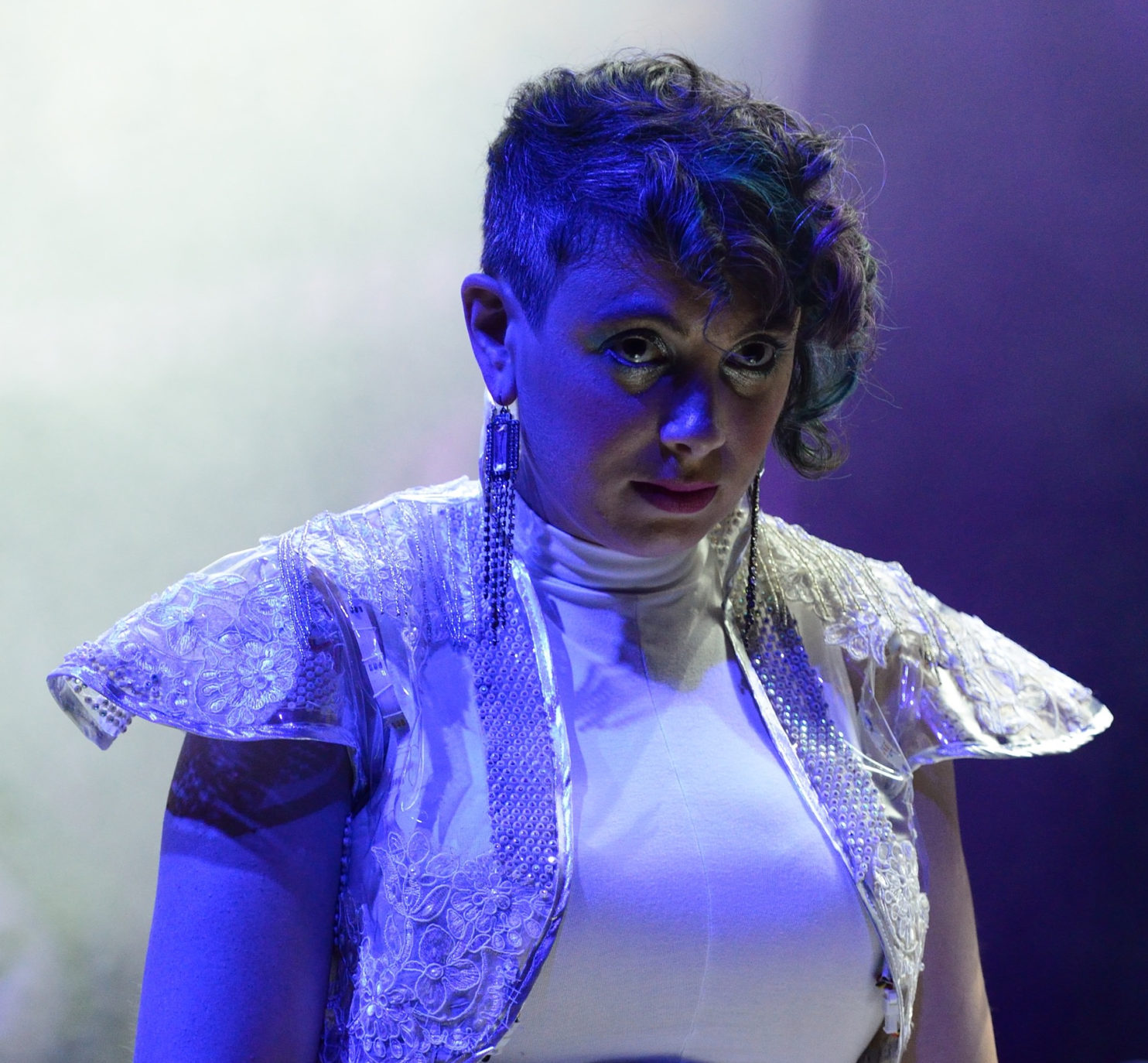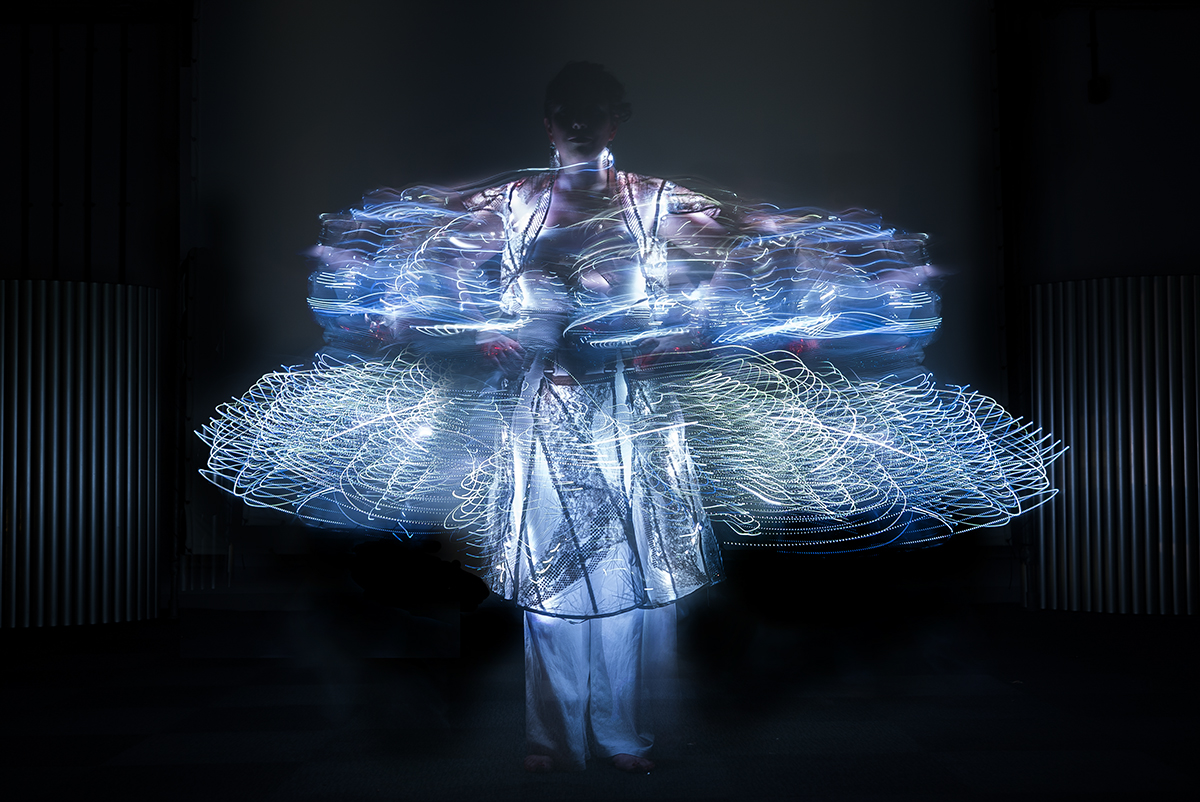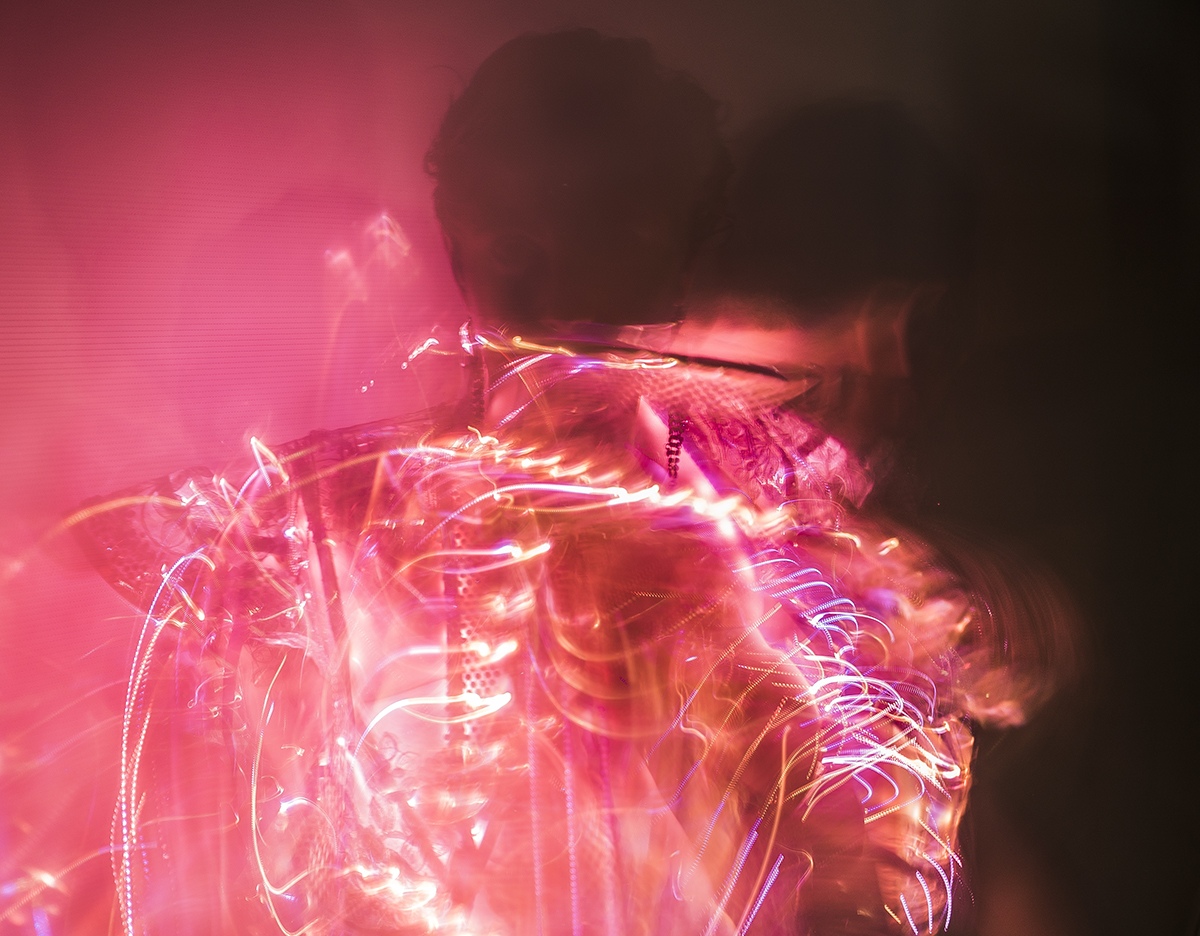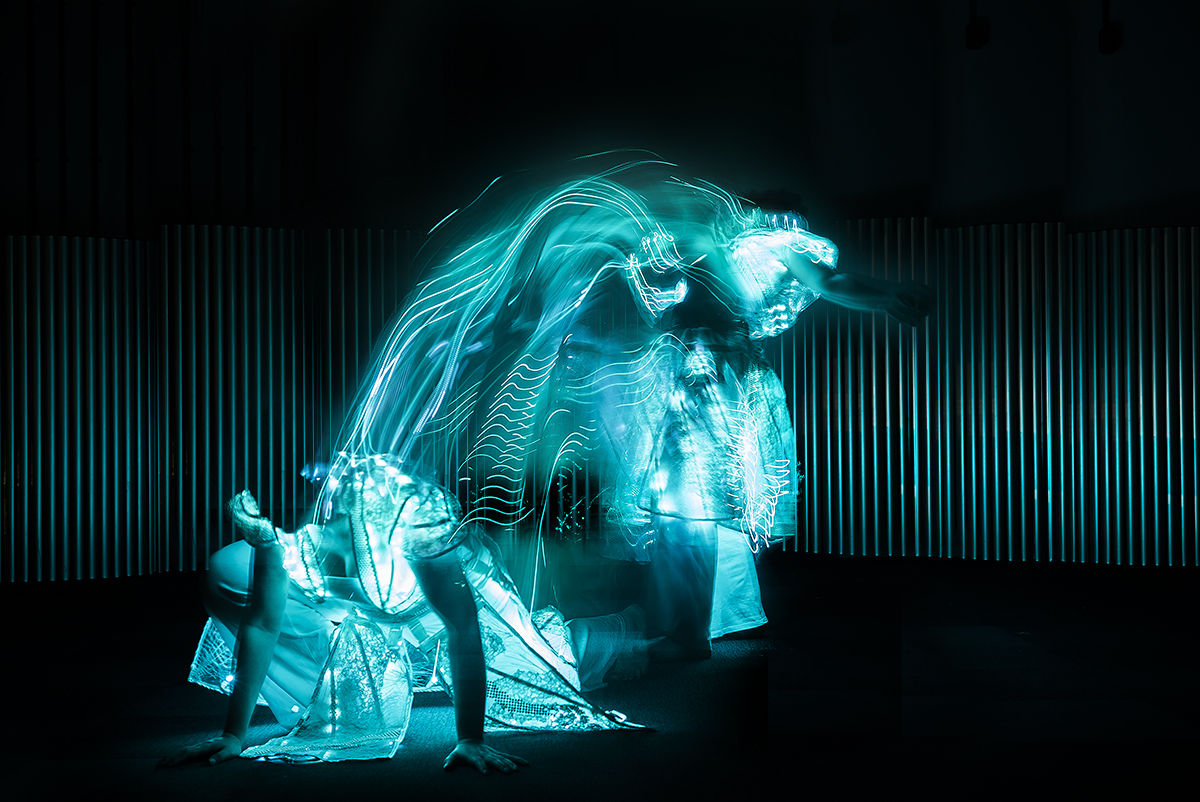Laura, tell us a bit about yourself and how did you end up in creative and tech industry.
I run a company called Hellion Trace. I set it up seven years ago to specialise in fusing movement and technology together. My work with Hellion Trace tours worldwide and is about creating interactive installations, big city wide spectacles and interactive dance shows.
I actually got into the creative tech industry by accident, and now I wouldn’t leave. The audiences, environments and new movement vocabularies I’m exploring because of the symbiotic relationship between movement and technology is the most dynamic, creative and inspiring space to work in. I love the fact that my work takes me into the music, fashion, brands, wearables, dance and city development industries. I love the fluidity of the projects we work on at Hellion Trace.
My background was initially as a choreographer for theatre and musical theatre but I saw a massive divorce in our relationship with movement as we no longer have a strong physical rhythm in our bodies. My exploration into tech was initially about bringing the use of composition and movement into public spaces. What I quickly discovered were different collaborators, from scientists to crane mechanics, new ways of working, innovative movement qualities, new physical languages, locations and audiences: And there was no turning back.
What projects are you working on at the moment?
I’ve just started a great new fellowship with Keychange.eu, all about creating gender parity in the music industry. This is an opportunity to really interrogate the audiences, market and musicality for my work with Hellion Trace, especially through my project, Kicking the Mic.
Fusing live tap dance, looping and a fully sound reactive LED dress, Kicking the Mic takes the rhythmical percussive sounds of tap dance turned into samples of different instruments, from flutes to cellos to tablas. The dancer loops and layers these sounds, creating danced compositions. It is combined with an LED dress that lights up and changes colour to the live sounds, creating a visual score to the music and dance. Kicking the Mic has already been performed worldwide in US, Japan, France, Germany and India. I’m working on the second half of the show, designing new animations for the LED dress, and writing new tracks that really make the most of the wireless looping unit I designed: We’re touring from August 2018 - so do get in touch if you would like to book the project for conferences and performances.
What are your biggest achievements to date?
- Producing the UK’s first transfer of the Museum of Broken Relationships: taking London by storm.
- Being a Clore Cultural Leadership Fellow
- Being one of the three world wide WIRED Creative Fellows
- 10,000 people coming to see 3 industrial construction cranes do a synchronised dance routine.
- Building the systems for, and performing Kicking the Mic all over the world.
- Learning to sail solo.
How about the biggest obstacles?
One of the biggest obstacles I’ve faced is other people’s anticipation of who you are and what you do. I have made 4 or 5 large career changes, for the right personal reasons, but which others have perceived as foolish. I don’t regret any of them and have always excelled in the new industry because I’ve been following the right personal drivers and motivation.
To put this in context: I was running a theatre when I decided to produce the Museum of Broken Relationships. I was working as a choreographer for musical theatre when I started exploring technology. I was creating interactive dance shows when I started making citywide interventions.
I think there is something very interesting that women need to unravel about how we’re often taught to believe that there is someone better than us who should be asking for the money, someone better at performing, better at negotiating the contract, better at inventing things. It’s very hard to overcome this, especially when you are working in really forward-thinking industries, and to trust that it can and could and should be oneself making/ undertaking this projects.
I’m interested in what happens when we don’t give into that social norm. If we believe in our potential what different ideas, ways of working, products and voices we’ll hear. So the biggest obstacle is always holding one’s nerve, for far longer than one might anticipate.
And then there’s always the joy of project budgets versus the cost of projects versus my ambition.
What is the idea behind Kicking the Mic and how did you come up with it?
I had been working on a range of projects with dancers where we were creating and manipulating both the visuals and the compositional elements. There was this really interesting pub conversation where the creative team kept circling around at the end of rehearsals and saying, “Are we composing choreography, or choreographing composition?”
This struck me as such a fascinating question. I brought together a group of collaborators, and we started to play, with some new tools initially just for two days and I was hooked. By working with a rhythmical dance form like tap, we were able to create really tight rhythmical phrases and all the other pieces fell into place. Each different instrument inspired a different quality of movement, so influencing the physical form. Creating the wireless looper allowed us to build a maturity to the choreographic phrases and the music. Adding vocals made the work accessible, and the LED Dress? Well, seeing sound is an extraordinary synaesthetic experience.
The magic is the live combination of the elements. Our high fashion costume, where we use light reflected off the dancer’s form with beautiful sound reactive visuals that react to live sound; our low latency tech robustly giving the dancer physical freedom on stage whilst live looping; and the compositional style of the show that really generating quotes like this:
"Sublime... from the tightly choreographed tap routines to the arresting moments of beauty where technology and performer respond to each other” Japan
I love performing the piece: it never feels like it’s just me on stage: it’s like being in the middle of a Greek Chorus, with the computer choosing the melody, and the dress allowing me to appear and disappear, and then impact of looping and layering sound.
What does the #WomenInTech movement mean to you? What are the challenges of being a woman in tech / STEM?
The #WomenInTech moment helps me find peers: To feel less isolated, to believe in my instincts. It helps me find collaborators and champions.
The challenges are obvious: getting the glass ceiling smashed. Getting the seed funding. Getting the commissions to change whole cities. Getting the mansplainers to stop telling me (badly) about everything I’ve worked on for the last 7 years. Getting the guys at the dinner party to stop being gobsmacked and then making ‘witty comments’ when you’re eloquent and well read and well researched and can hold your own. Getting parity to the point where being a female creative director, and creative technologist, and designer and artist, and producer and hustler isn’t the thing commented on. Getting to the point when the market is as financially beneficial for a woman and a man.
What are the challenges of being a creative technologist in the niche you are in? How about being a female designer and innovator?
See above? There are structural challenges worldwide that our still limiting our impact and presence in certain industries. That landscape is changing, but not fast enough, and not in the high capitalist world.
For me, our work is at it’s best when we are creating in an unknown landscape: my collaborators and I are always inventing new languages, new tech, new design solutions, so I feel Hellion Trace’s working processes mitigate these challenges. These structural challenges aren’t present in my generation and collaborators, but they are in the world around us.
What is the most important piece of advice you can give to all women in creative tech out there?
Just start: begin, try it, film it, make it, do it, make the cardboard version, the arduino version, the python, the sparkfun the anything version. But just do it.
And then don’t give up. Ask for help - keep questioning, keep refining but believe you have the right to do it.
In your opinion, what will be the key trends in the wearable tech industry in the next 5 years and where do you see it heading?
The biggest breakthroughs will combine physical and digital creative experiences.
On the hightech end: 5G is going to totally revolutionise our relationship with latency and and collective live experiences and with touch in physical/ digital experiences.
On the low tech end: the most extraordinary developments, apps and platforms are being made that work on older, simpler devices. I think we’re going to be really surprised by the resilience and creativity that this inspires.
Who are your 3 inspirational women in wearable tech / tech in general?
Clare Reddington, Creative Director of the Watershed Bristol (and the brains behind The Pervasive Media Studio and Playable City movement). Clare’s robust and honest, and full of humour and joy and incredibly insightful. She’s a connector and unstoppable.
Alisee de Tonnac, who runs Seedstars Worldwide. Alisee has built a brilliant model for supporting and developing companies in the emerging markets- and it’s really working.
Sammy Payne, COO of Open Bionics. Sammy is revolutionising prosthetics, whilst championing open source practices.
This interview was published on the Women Of Wearables Website on 3rd May 2018.



